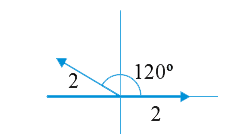The maximum and minimum magnitude of the resultant of two given vectors are 17 units and 7 unit respectively. If these two vectors are at right angles to each other, the magnitude of their resultant is
14
16
18
13
The correct Answer is:D
To solve the problem step by step, we will use the information provided about the maximum and minimum magnitudes of the resultant of two vectors.
Step 1: Understand the Problem
We are given two vectors, A and B, with the maximum resultant Rmax=17 units and the minimum resultant Rmin=7 units. We need to find the magnitude of the resultant when these two vectors are at right angles to each other.
Step 2: Set Up the Equations
The maximum resultant occurs when the two vectors are in the same direction:
Rmax=A+B
From the problem, we know:
A+B=17(Equation 1)
The minimum resultant occurs when the two vectors are in opposite directions:
Rmin=|A−B|
From the problem, we know:
A−B=7(Equation 2)
Step 3: Solve the Equations
Now we will solve these two equations simultaneously.
1. From Equation 1:
A+B=17
2. From Equation 2:
A−B=7
We can add these two equations:
(A+B)+(A−B)=17+7
This simplifies to:
2A=24⟹A=12
Now, substitute A=12 back into Equation 1 to find B:
12+B=17⟹B=5
Step 4: Calculate the Resultant When Vectors are Perpendicular
When the vectors A and B are at right angles (90 degrees), the magnitude of the resultant R is given by:
R=√A2+B2
Substituting the values of A and B:
R=√122+52=√144+25=√169=13
Conclusion
The magnitude of the resultant of the two vectors when they are at right angles to each other is 13 units.
We are given two vectors, A and B, with the maximum resultant Rmax=17 units and the minimum resultant Rmin=7 units. We need to find the magnitude of the resultant when these two vectors are at right angles to each other.
The maximum resultant occurs when the two vectors are in the same direction:
Rmax=A+B
From the problem, we know:
A+B=17(Equation 1)
Rmin=|A−B|
From the problem, we know:
A−B=7(Equation 2)
Now we will solve these two equations simultaneously.
A+B=17
2. From Equation 2:
A−B=7
(A+B)+(A−B)=17+7
This simplifies to:
2A=24⟹A=12
12+B=17⟹B=5
When the vectors A and B are at right angles (90 degrees), the magnitude of the resultant R is given by:
R=√A2+B2
Substituting the values of A and B:
R=√122+52=√144+25=√169=13
The magnitude of the resultant of the two vectors when they are at right angles to each other is 13 units.
Similar Questions
The maximum and minimum magnitudes of the resultant of two vectors are 23 units and 7 units respectively. If these two vectors are acting at right angles to each other, the magnitude of their resultant will be
View SolutionThe maximum and minimum magnitudes of the resultant of two vectors are 23 units and 7 units respectively. If these two vectors are acting at right angles to each other, the magnitude of their resultant will be
View Solution
Knowledge Check
If the sum of two unit vectors is a unit vector, then the magnitude of their difference is :
A√3B√2C√5D1√2
The maximum and minimum magnitudes of the resultant of two forces are 5 N and 5N respectively. Find the magnitude of resultant force when act orthogonally to each other.
View SolutionFind the magnitude and direction of the resultant of given vectors

View SolutionIf three unit vectors are inclined at an angle of 60∘ with each other, then the magnitude of their resultant vector will be
View SolutionMaximum and minimum magnitudes of the resultant of two vectors of magnitudes P and Q are in the ratio 3:1. Which of the following relation is true?
View SolutionThe ratio of maximum and minimum magnitudes of the resultant of two vectors →a and →b is 3:1. Now, |→a| is equal to
View SolutionThe ratio of maximum and minimum magnitudes of the resultant of two vectors →a and →b is 3:1. Now, |→a| is equal to
View SolutionThe ratio of maximum and minimum magnitude of the resultant of two vectors →A and →B is 3:2. The relation between A and B is
View Solution
